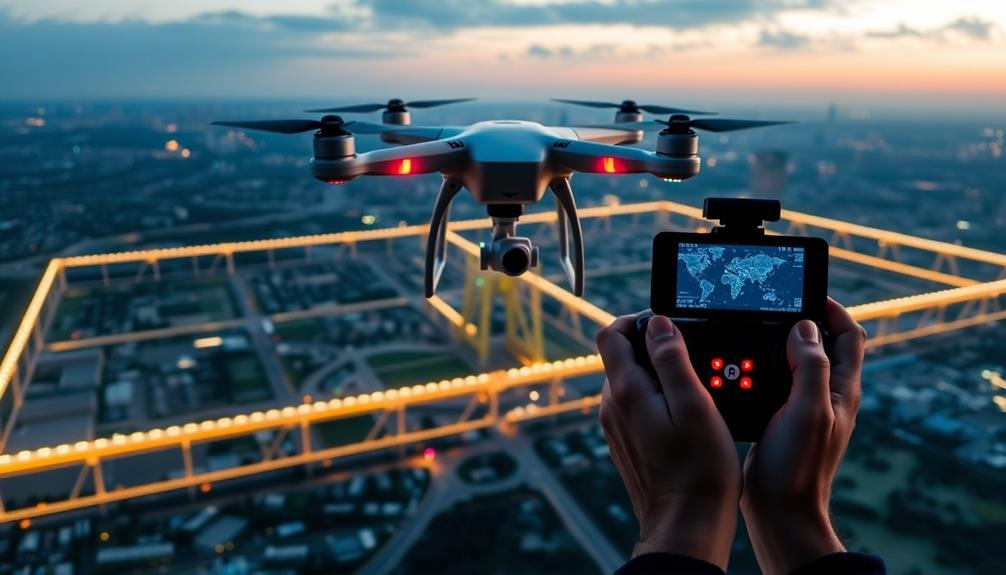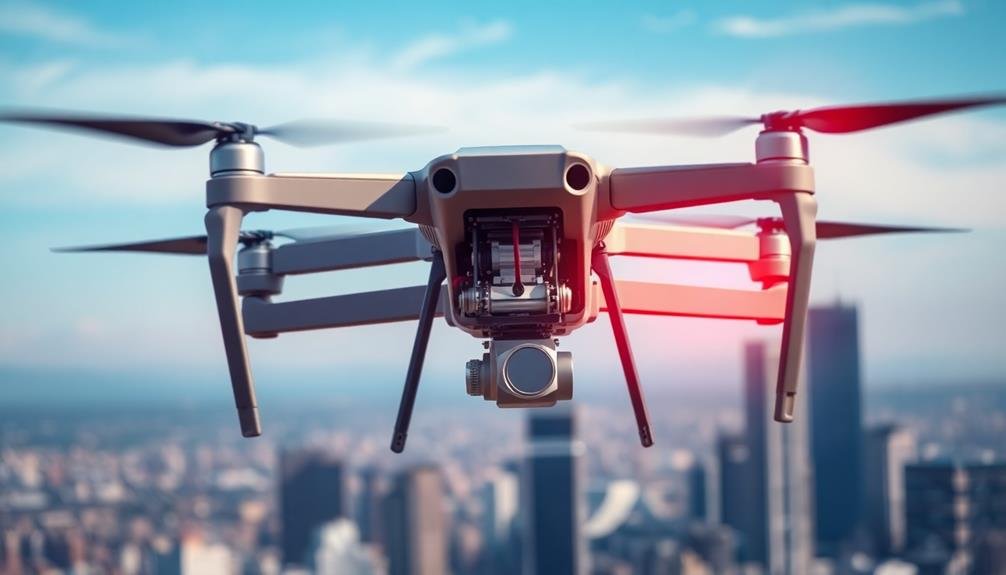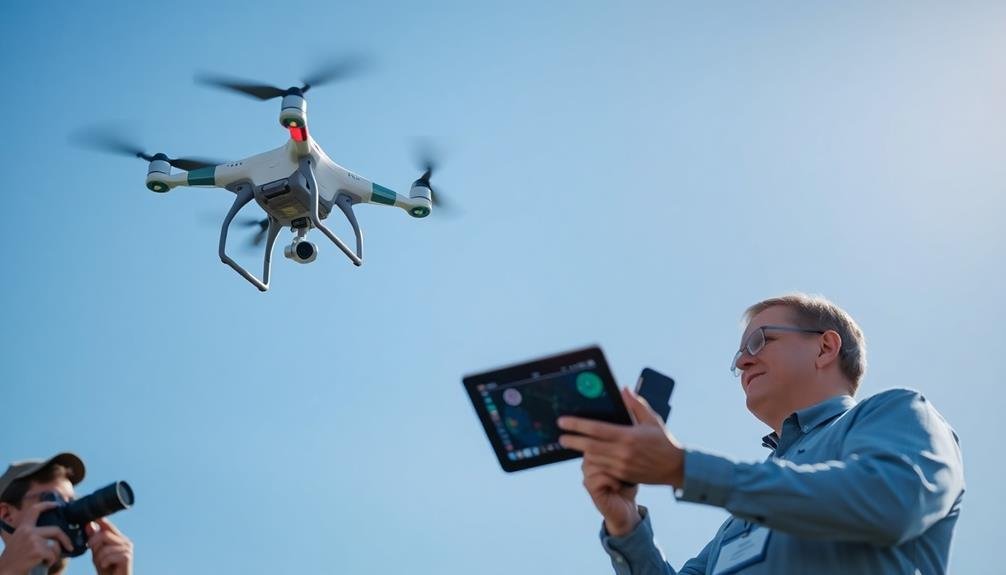For safe aerial photography, you'll need seven vital features on your drone. Obstacle avoidance systems protect against collisions, while return-to-home functions guarantee your drone comes back safely. Geofencing capabilities prevent flying into restricted areas, and low battery warnings alert you before power runs out. GPS-assisted flight modes enhance stability and control, while redundant propulsion systems provide backup in case of failure. Finally, remote ID technology helps you comply with regulations and promotes safer airspace. By prioritizing these safety features, you'll minimize risks and maximize your chances of capturing stunning aerial shots. Dive deeper to explore how each feature can elevate your aerial photography game.
Key Takeaways
- Obstacle avoidance systems use sensors to detect and avoid hazards, ensuring safe flight paths during aerial photography sessions.
- Return-to-Home function automatically brings the drone back to its takeoff point if signal is lost or battery is low.
- Geofencing capabilities create virtual boundaries to prevent flying into restricted areas and maintain legal compliance.
- Low battery warning alerts prompt timely return actions, preventing mid-air power loss during shoots.
- GPS-assisted flight modes enhance stability and precision for capturing high-quality aerial photographs, especially in challenging conditions.
Obstacle Avoidance Systems

Nearly all modern drones equipped for aerial photography come with built-in obstacle avoidance systems. These systems use a combination of sensors, including visual cameras, infrared sensors, and ultrasonic detectors, to identify potential hazards in the drone's flight path.
As you navigate your drone, these sensors continuously scan the environment, detecting objects such as trees, buildings, power lines, and even moving obstacles like birds. When an obstacle is detected, the system will either automatically adjust the drone's flight path to avoid collision or alert you to take manual control.
Some advanced systems can create 3D maps of the surrounding area, allowing for more precise navigation in complex environments. You'll find that obstacle avoidance technology considerably reduces the risk of accidents, especially when flying in unfamiliar or crowded locations.
It's essential to understand your drone's specific obstacle avoidance capabilities and limitations. Some systems may not function as effectively in low-light conditions or at high speeds.
Always maintain visual line of sight with your drone and be prepared to take manual control if necessary. Regular firmware updates can improve the performance of these systems, so keep your drone's software current for ideal safety.
Return-to-Home Function

The Return-to-Home (RTH) function is a critical safety feature in modern drones used for aerial photography. This automated system guarantees your drone can safely return to its takeoff point or a predetermined location if it encounters issues during flight.
You'll find RTH particularly useful in situations where you lose control signal, face low battery levels, or need to recall your drone quickly.
When activated, RTH guides your drone back using GPS coordinates. It'll typically ascend to a safe altitude to avoid obstacles before flying directly to the home point. You can usually customize this altitude in your drone's settings to suit your environment.
It's essential to understand how RTH works on your specific drone model. Some drones will hover briefly before initiating RTH, while others may return immediately.
You should also be aware of potential limitations, such as GPS signal interference in urban areas or near large structures.
To make the most of this feature, always verify your home point is accurately set before takeoff.
Geofencing Capabilities

Another essential safety feature in modern drones is geofencing capabilities. This technology creates virtual boundaries that restrict your drone's flight path, helping you avoid restricted areas and potential legal issues. Geofencing uses GPS or RFID technology to define geographical boundaries, ensuring your drone stays within safe and permitted zones.
When you're planning your aerial shoot, geofencing can be a game-changer for safety and compliance. Here's how it can benefit you:
- Prevents accidental flights into restricted airspace
- Alerts you when approaching no-fly zones
- Automatically stops your drone at predefined boundaries
- Allows you to create custom flight zones for specific projects
You'll find that many professional-grade drones come with built-in geofencing systems, often with regularly updated databases of restricted areas.
However, it's vital to remember that while geofencing is a valuable tool, it's not infallible. You're still responsible for knowing and following local regulations.
To make the most of geofencing, familiarize yourself with your drone's specific capabilities and always double-check local flight restrictions before taking off. This proactive approach will help you capture stunning aerial shots while prioritizing safety and legal compliance.
Low Battery Warning Alerts

When your drone's battery starts running low, you'll appreciate the built-in low battery warning alerts.
These alerts typically include timely Return-To-Home prompts, ensuring you have enough power to safely land your drone.
You'll also find battery percentage indicators on your controller or app, allowing you to monitor power levels throughout your flight and plan accordingly.
Timely Return-To-Home Prompts
Three vital battery alerts guarantee you don't lose your drone due to power failure. The most vital of these is the timely return-to-home (RTH) prompt. This feature guarantees you're aware when it's time to bring your drone back before the battery depletes entirely.
Modern drones use sophisticated algorithms to calculate the remaining battery life and the distance to the home point. They'll trigger an RTH prompt when they determine there's just enough power to make it back safely. You'll typically receive this alert through your controller's display or mobile app.
To make the most of RTH prompts:
- Set your home point accurately before each flight
- Keep an eye on wind conditions, as they can affect battery consumption
- Don't ignore or override RTH prompts unless absolutely necessary
- Familiarize yourself with your drone's specific RTH behavior
Battery Percentage Indicators
Alongside RTH prompts, battery percentage indicators provide essential information about your drone's remaining power. These indicators typically display the current battery level as a percentage or through a color-coded system. You'll find this information on your remote controller's screen or within your drone's mobile app.
Most drones feature multi-stage low battery warnings. You'll receive initial alerts when your battery reaches around 30% capacity, giving you ample time to plan your landing. As the battery depletes further, you'll get more urgent warnings at 20% and 10%. It's vital to heed these alerts and begin your descent immediately.
Some advanced drones calculate remaining flight time based on current conditions, factoring in wind speed and distance from the home point. This feature helps you make informed decisions about when to end your flight.
To maximize safety, always start your aerial shoots with a fully charged battery. Monitor your battery levels consistently throughout your flight, and don't push your drone to its limits.
GPS-Assisted Flight Modes

GPS-assisted flight modes are game-changers in aerial photography safety. They provide you with advanced features that enhance control and stability during your shoots. These modes utilize satellite positioning to maintain the drone's location, altitude, and orientation, allowing you to focus on capturing the perfect shot.
With GPS-assisted flight modes, you'll benefit from:
- Return-to-home functionality
- Geofencing capabilities
- Hover accuracy in windy conditions
- Precise waypoint navigation
You'll find that these modes considerably reduce the risk of flyaways and crashes, especially in challenging environments. They're particularly useful when you're shooting in unfamiliar locations or dealing with complex compositions.
Many modern drones offer multiple GPS-assisted flight modes, each tailored to specific shooting scenarios. For instance, you might use a follow-me mode for action shots or a point-of-interest mode for orbiting around a subject.
These intelligent features not only improve safety but also expand your creative possibilities.
Redundant Propulsion Systems

When it comes to redundant propulsion systems, you'll find several key safety features in modern aerial photography drones.
Dual motor configurations and backup propeller systems guarantee your drone can maintain flight even if one component fails.
These redundancies, coupled with emergency landing capabilities, considerably reduce the risk of crashes and protect your valuable equipment during unexpected malfunctions.
Dual Motor Configurations
Dual motor configurations represent a critical safety feature in aerial photography drones. This redundancy guarantees that if one motor fails, you'll still have enough power to safely land your drone and protect your expensive camera equipment. By using two motors instead of one, you're greatly reducing the risk of a catastrophic failure during your aerial shoot.
When you're considering a drone with dual motors, keep these key benefits in mind:
- Improved stability: Two motors provide better balance and control, especially in windy conditions.
- Enhanced lift capacity: You'll be able to carry heavier camera payloads with ease.
- Increased flight time: The workload is distributed between two motors, potentially extending your shooting time.
- Faster ascent and descent: Dual motors offer more power for quicker vertical movements.
You'll find that dual motor configurations aren't just about safety; they also improve your overall shooting experience.
With better stability and control, you can capture smoother footage and more precise shots. The added power allows you to react quickly to changing conditions or subject movements, guaranteeing you don't miss that perfect shot.
While dual motor drones may cost more initially, the investment in safety and performance is well worth it for professional aerial photographers.
Backup Propeller Systems
Redundancy isn't just for motors; it's vital for propellers too. When you're conducting aerial photography, backup propeller systems can be the difference between a successful shoot and a catastrophic failure. These systems typically involve additional propellers that can quickly deploy if the primary ones fail or become damaged.
You'll find that many advanced drones come equipped with foldable backup propellers. These are stored within the drone's body and can automatically unfold and engage when needed. Some models even feature quick-release mechanisms that allow you to manually replace damaged propellers mid-flight.
It's important to understand that backup propeller systems aren't just about having spare parts. They're integrated into the drone's flight control system, enabling seamless changeover if a propeller fails. This integration guarantees that your drone maintains stability and control, even in challenging conditions.
When choosing a drone for aerial photography, prioritize those with robust backup propeller systems. Look for features like automatic deployment, compatibility with the drone's flight controls, and easy manual replacement options.
Emergency Landing Capabilities
Nearly all professional-grade drones for aerial photography now come equipped with redundant propulsion systems. These systems are designed to prevent catastrophic failures and guarantee you can safely land your drone in case of motor or propeller issues.
You'll find that most high-end drones can maintain flight even if one or more motors fail, giving you vital time to navigate to a safe landing spot.
When choosing a drone for aerial photography, look for models with advanced emergency landing capabilities. These features typically include:
- Return-to-home function
- GPS-assisted hovering
- Obstacle avoidance sensors
- Automatic landing in low-battery situations
You should familiarize yourself with your drone's emergency procedures before each flight. Practice using the return-to-home function and learn how to manually trigger an emergency landing.
It's also wise to scout potential landing areas before takeoff, especially when flying in unfamiliar locations. Remember, even with redundant systems, you're responsible for your drone's safe operation.
Always maintain visual line of sight and be prepared to take manual control if necessary. By understanding and utilizing your drone's emergency landing capabilities, you'll greatly reduce the risk of accidents and protect your valuable equipment.
Remote ID Technology

Remote ID technology is revolutionizing drone safety and accountability. As a photographer using drones for aerial shoots, you'll need to understand and implement this vital feature.
Remote ID acts like a digital license plate for your drone, broadcasting its location, altitude, and identification information to nearby receivers.
You'll find that Remote ID helps prevent airspace violations and enhances overall safety. It allows authorities to identify and track drones in real-time, reducing the risk of collisions with other aircraft or interference with sensitive areas.
For your photography work, this means you can operate with greater confidence, knowing that your drone is easily identifiable and compliant with regulations.
To use Remote ID, you'll need to make certain your drone is equipped with this technology or use an add-on module. Many newer models come with built-in Remote ID capabilities.
You'll also need to register your drone and obtain the necessary certifications. By embracing Remote ID, you're not only complying with regulations but also contributing to a safer airspace for everyone.
It's an essential tool for responsible drone operation in your aerial photography endeavors.
Frequently Asked Questions
How Do Weather Conditions Affect Aerial Photography Safety?
Weather conditions greatly impact your aerial photography safety. You'll face risks from high winds, rain, fog, and extreme temperatures. They can affect visibility, drone stability, and equipment performance. Always check forecasts and avoid flying in hazardous conditions.
What Insurance Coverage Is Recommended for Aerial Photography?
You'll want thorough liability insurance that covers equipment damage, personal injury, and property damage. Don't forget to include drone-specific coverage if you're using UAVs. It's also wise to have professional indemnity insurance for your work.
Are There Specific Certifications Required for Commercial Aerial Photography?
Yes, you'll need specific certifications for commercial aerial photography. You must obtain a Remote Pilot Certificate from the FAA by passing the Part 107 exam. Additionally, you'll need to register your drone and follow local regulations.
How Often Should Aerial Photography Equipment Be Inspected and Maintained?
You should inspect and maintain your aerial photography equipment before every flight. It's essential to check batteries, propellers, cameras, and mounts daily. Schedule thorough inspections monthly and service your gear annually for best performance and safety.
What Are the Legal Restrictions on Flying Drones Near Airports?
You're restricted from flying drones within 5 miles of airports without prior authorization. You'll need to notify air traffic control and get permission. There are also strict altitude limits and no-fly zones to take into account.
In Summary
You've now got the lowdown on vital safety features for aerial photography. Don't skimp on these when choosing your drone. They'll keep you, your equipment, and others safe while you capture stunning shots. Remember, safety isn't just a bonus – it's essential. Stay informed about local regulations and always fly responsibly. With these features in place, you're ready to take your aerial photography to new heights. Happy flying!

As educators and advocates for responsible drone use, we’re committed to sharing our knowledge and expertise with aspiring aerial photographers.




Leave a Reply